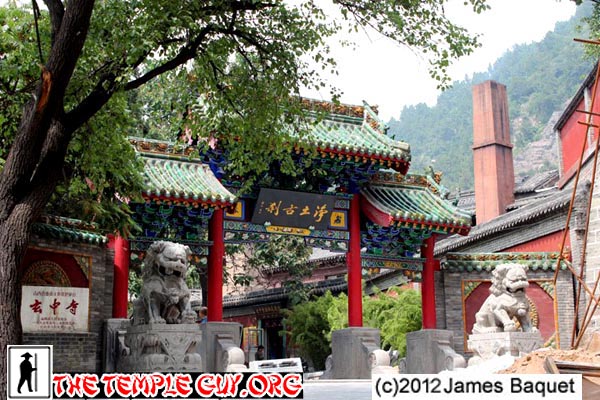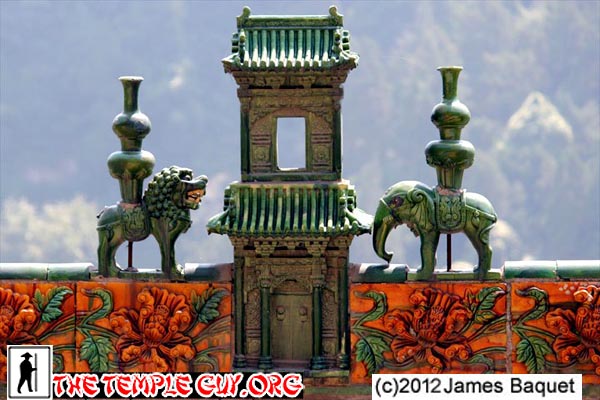(1) Xuanzhong Temple is considered the "ancestral temple" of the Pure Land Sect, the most popular form of Buddhism in China and Japan. The temple sits in a gorgeous cleft in the mountains, where access is a little tough, but it was well worth the effort.
I actually paid a taxi to take me from the bus station to this parking lot. From there it's a short climb to the gate. The red wall in this picture is not the temple compound, but the back of some shops (which I'm sure belong to the temple).
Here's an excellent article on Pure Land Buddhism that mentions this temple.
(2) In preparing for this visit, I came across a birders' page whose members were very excited about the fact that you could see the "brown-eared pheasant" outside the temple, where the monks feed them in winter. Guys were willing to come from all over the world just to see this bird. Well, I did! Stuffed in front of a shop, unfortunately. So much for compassion for all sentient beings.
(3) The proper entrance to the temple
(4) I was awestruck by the Heavenly Kings in this place. Gorgeous.
(5) Another verdant courtyard. This temple is known for the quality of its steles; two are enshrined here.
(6) A full-frontal of the main hall, with the mountain behind
(7) A more artsy shot of the main hall; this is the view from where I sat to say my prayers, as monks and laywomen were busy inside the hall setting up for Ghost Festival ceremonies. BTW seeing the setup they were working on confirmed for me that the picture I took a few days ago on Wutai Shan, with the candles in a diamond shape, was in fact an offering for the hungry ghosts.
(8) As the seat of Pure Land Buddhism, Xuanzhong Si would naturally have an Amitabha Buddha in the center of the altar, but the small jade Shakyamuni was a surprise.
(9) Although there are in fact small statues of the 16 (not 18) arhats ranged around the hall, the scrolls are more notable. I'd love to find a set of those in Dafen Village!
(10) I was charmed by this small courtyard to the west of the main hall. I'd love to live in a place like that!
(11) Behind the main hall, these stairs lead up to another courtyard surrounded by two-story buildings.
(12) The walls of three of the halls around the upper courtyard were covered with murals. This one, in the Patriarchs' Hall (downstairs in the center building) featured a view of the temple itself.
(13) Upstairs on the right is a Guanyin Hall, with a fine smallish statue of the Bodhisattva of Compassion, and wonderful murals showing him/her saving people in distress.
(14) Upstairs on the left is a Dizang Hall, with a fine smallish statue of the Bodhisattva Who Saves Beings from Hell, and wonderful murals showing him saving people, as well as some "hellish" figures like these (judges?).
(15) This small hall sits isolated to the west of the temple. Two people informed me that it is a Taoist hall, not part of the temple, dedicated to a god of the mountain.
(16) Another roof crest, this one at eye level from a hall above it. The elephant represents Puxian, the Bodhisattva of Great Practice, and the lion represents Wenshu, the Bodhisattva of Great Wisdom (whom we saw all over Wutai Shan). They are placed on the side of the roof corresponding to where they would be in the hall (if they were there).
(17) I was shooting for roofs, and in the process got the only view I'd get of the temple's tayuan or cemetery. It's just behind that long wall (you can barely make out one pagoda), and the gate to the area was locked when I descended to it.
(18) This pagoda, however, stands proudly on the top of an amazing hill. The path to it was blocked (probably unstable), so I couldn't climb up to it. So here are a few views, this one nearly eye-level from the top of the temple.
(18) This view of the pagoda is from below, down the road a bit, and using the telephoto. By the way, I don't know who the "occupant" is--yet.
(20) A much wider shot, showing the promontory on which the pagoda sits. The temple is below and to the left, behind the very green hill in the foreground.
+ + + + + + + +
And so--as I walked down the road, expecting to go the full 4km to the main road where I'd catch a local bus to the long distance bus station--a kind couple of tourists stopped and picked me up after I had gone less than 1km, and not only took me to the road, but drove me the full 8km or so to the bus station! Another blessing.
| ← Previous Site | Back to Trip 19 Introduction | Next Site → |
Last Updated August 21, 2019





















No comments:
Post a Comment